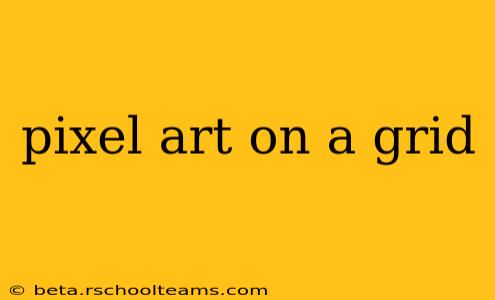Pixel art, with its charmingly retro aesthetic, continues to captivate artists and gamers alike. But what truly defines this unique art form? At its core, pixel art is all about creating images using a grid of individual pixels, each a single point of color. Understanding this grid system is paramount to mastering the craft. This article will explore the intricacies of pixel art on a grid, providing insights for both beginners and experienced artists.
The Power of the Grid: Structure and Precision
The grid in pixel art isn't merely a background; it's the very foundation of the artwork. Every pixel is meticulously placed, contributing to the overall composition. This structured approach demands precision and patience. Unlike traditional painting or drawing, there's no room for blurry lines or subtle shading techniques. Instead, artists must rely on strategic color placement and clever use of limited pixels to convey depth, form, and emotion.
Understanding Resolution and Grid Size:
The resolution of your grid directly impacts the detail you can achieve. A low-resolution grid (e.g., 8x8 pixels) necessitates simplification and bold color choices, lending itself to a classic, almost iconic look. Higher-resolution grids allow for more nuanced detail, but still maintain that distinct pixelated appearance. Experimenting with different grid sizes is key to finding your preferred style and understanding their limitations.
Mastering the Techniques: From Simple Shapes to Complex Scenes
Creating compelling pixel art involves more than just filling in squares. It requires a nuanced understanding of color theory, shape manipulation, and dithering techniques.
1. Shape and Form:
Building forms using only squares and rectangles demands a keen eye for design. Artists use adjacent pixels of different colors to create the illusion of curves and depth. Understanding basic geometric principles is essential for constructing recognizable objects and characters. Careful consideration of the placement of each pixel is crucial to create smooth transitions and avoid jarring results.
2. Color Palette Selection:
Limited color palettes are characteristic of pixel art. Choosing the right colors significantly impacts the mood and style of your piece. A vibrant palette can create energetic and playful pieces, while a muted palette can achieve a more subdued and atmospheric effect. Experimentation with different color combinations is encouraged to find the right palette to support the artwork's design.
3. Dithering:
Dithering is a technique that uses different colored pixels to simulate colors not present in the palette. By strategically arranging pixels, artists can create the illusion of gradients and smooth transitions, adding depth and complexity to the image. Mastering dithering requires a strong understanding of color mixing and pattern recognition. Different dithering patterns create vastly different effects, ranging from subtle blends to more pronounced textures.
Tools and Software: Your Digital Canvas
Numerous software options exist to aid pixel artists in their craft. Some popular choices include:
- Aseprite: A widely used and versatile program specifically designed for pixel art.
- Pyxel Edit: A free and open-source option offering a user-friendly interface.
- GraphicsGale: Another well-regarded option, known for its speed and ease of use.
The choice of software ultimately depends on individual preferences and workflow.
Conclusion: The Enduring Appeal of Pixel Art on a Grid
Pixel art on a grid presents a unique challenge and a rewarding creative outlet. The constraints of limited pixels and precise placement force artists to think creatively and strategically. The result is a distinct style characterized by its charm, precision, and often nostalgic appeal. By understanding the underlying principles and techniques, artists can unlock the full potential of this captivating art form, creating pixel art that is both visually stunning and emotionally resonant.
